Showing Spotlights 49 - 56 of 80 in category All (newest first):
 A very promising field of nanomotor research are DNA nanomachines. These are synthetic DNA assemblies that switch between defined molecular shapes upon stimulation by external triggers. They can be controlled by a variety of methods that include pH changes and the addition of other molecular components, such as small molecule effectors, proteins and DNA strands. Researchers have now designed and built a simple DNA machine that is capable of continuous rotation with controlled speed and direction - a function that might be very useful for example for molecular transport. This machine is driven by an externally controlled electric field. When this field is oscillated between four directions, it continuously reorients a rotor DNA that is asymmetrically attached to a DNA axle.
A very promising field of nanomotor research are DNA nanomachines. These are synthetic DNA assemblies that switch between defined molecular shapes upon stimulation by external triggers. They can be controlled by a variety of methods that include pH changes and the addition of other molecular components, such as small molecule effectors, proteins and DNA strands. Researchers have now designed and built a simple DNA machine that is capable of continuous rotation with controlled speed and direction - a function that might be very useful for example for molecular transport. This machine is driven by an externally controlled electric field. When this field is oscillated between four directions, it continuously reorients a rotor DNA that is asymmetrically attached to a DNA axle.
Jan 12th, 2010
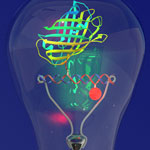 One challenge in designing nanomachines is being able to establish how well they work and optimize their performance. This is where single molecule techniques will play an important role. With advances in nanotechnologies, it is possible to construct simple nanomachines that can perform simple functions such as opening and closing of a DNA device (e.g. DNA tweezers or DNA switches), small rotational and translational motors and energy transfer cascades. Using single-molecule techniques researchers can watch individual nanomachines working and determine the functionality of their design. Researchers in Germany now have incorporated optical addressability to these nanomachines. Hence, they can optically detect and eventually control the state of the nanodevice.
One challenge in designing nanomachines is being able to establish how well they work and optimize their performance. This is where single molecule techniques will play an important role. With advances in nanotechnologies, it is possible to construct simple nanomachines that can perform simple functions such as opening and closing of a DNA device (e.g. DNA tweezers or DNA switches), small rotational and translational motors and energy transfer cascades. Using single-molecule techniques researchers can watch individual nanomachines working and determine the functionality of their design. Researchers in Germany now have incorporated optical addressability to these nanomachines. Hence, they can optically detect and eventually control the state of the nanodevice.
Dec 23rd, 2009
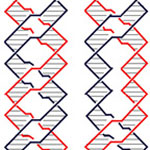 Reciprocating devices are a common part of the macroscopic world. Examples of reciprocating machines are petrol and diesel engines or a hydraulic pump. At the core of these machines is a piston and cylinder assembly where the piston executes a reciprocating motion inside the cylinder. Reciprocating motion like that in a piston has not been available in a nanoscale machine until now. Ned Seeman and his team at New York University have designed a DNA device that exhibits reciprocal motion. They have used the PX-JX2 device, a robust sequence-dependent nanomechanical DNA machine, as the basis for constructing a pair of reciprocal devices, wherein one device assumes one state, while the other device assumes the opposite state.
Reciprocating devices are a common part of the macroscopic world. Examples of reciprocating machines are petrol and diesel engines or a hydraulic pump. At the core of these machines is a piston and cylinder assembly where the piston executes a reciprocating motion inside the cylinder. Reciprocating motion like that in a piston has not been available in a nanoscale machine until now. Ned Seeman and his team at New York University have designed a DNA device that exhibits reciprocal motion. They have used the PX-JX2 device, a robust sequence-dependent nanomechanical DNA machine, as the basis for constructing a pair of reciprocal devices, wherein one device assumes one state, while the other device assumes the opposite state.
Jun 11th, 2009
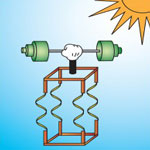 Molecular-size motors have evolved in nature, where they are used in virtually every important biological process. In contrast, the development of synthetic nanomotors that mimic the function of these amazing natural systems and that could be used in man-made nanodevices is in its infancy. Building nanoscale motors is not just an exercise in scaling down the design of a macroworld engine to nanoscale dimensions. In addition to organic molecules, scientists increasingly are looking to DNA as a very promising way to fabricate nanomotors. The concept of a single DNA molecule nanomotor was already introduced in early 2002. However, this and subsequent designs require addition and removal of fuel and waste strands for motor function, although some artificial nanomotors can utilize alternative energy sources, including hydrolysis of the DNA backbone and ATP. Researchers at the University of Florida have now designed a photoswitchable single-molecule DNA nanomotor. It is the first fully reversible single-molecule DNA nanomachine driven by photons without any additional DNA strands as fuel.
Molecular-size motors have evolved in nature, where they are used in virtually every important biological process. In contrast, the development of synthetic nanomotors that mimic the function of these amazing natural systems and that could be used in man-made nanodevices is in its infancy. Building nanoscale motors is not just an exercise in scaling down the design of a macroworld engine to nanoscale dimensions. In addition to organic molecules, scientists increasingly are looking to DNA as a very promising way to fabricate nanomotors. The concept of a single DNA molecule nanomotor was already introduced in early 2002. However, this and subsequent designs require addition and removal of fuel and waste strands for motor function, although some artificial nanomotors can utilize alternative energy sources, including hydrolysis of the DNA backbone and ATP. Researchers at the University of Florida have now designed a photoswitchable single-molecule DNA nanomotor. It is the first fully reversible single-molecule DNA nanomachine driven by photons without any additional DNA strands as fuel.
Jun 10th, 2009
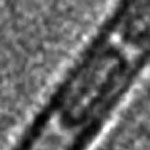 Just a few days ago we covered the exciting and quickly developing world of nanotechnology machinery, specifically nanomotors. In this previous Nanowerk Spotlight we focused on one approach to nanomotors, which is copying nature's catalytic biomotors. Today we will look at an example of mechanical approach that works with carbon nanotubes (CNTs). Some experimental work concerning CNT motor system has already been reported, but new work coming out of Japan could very well be the smallest motor so far. Researchers in Japan investigated the linear and rotary motions of a CNT capsule at room temperature when it is sealed by other CNTs in a hollow space of a host CNT. It is the first observation of linear motion of CNT capsules. Such a system can be obtained by simply heating C60 peapods, and its size is comparable or much smaller than well-known protein-based molecular motors in the bioengineering field.
Just a few days ago we covered the exciting and quickly developing world of nanotechnology machinery, specifically nanomotors. In this previous Nanowerk Spotlight we focused on one approach to nanomotors, which is copying nature's catalytic biomotors. Today we will look at an example of mechanical approach that works with carbon nanotubes (CNTs). Some experimental work concerning CNT motor system has already been reported, but new work coming out of Japan could very well be the smallest motor so far. Researchers in Japan investigated the linear and rotary motions of a CNT capsule at room temperature when it is sealed by other CNTs in a hollow space of a host CNT. It is the first observation of linear motion of CNT capsules. Such a system can be obtained by simply heating C60 peapods, and its size is comparable or much smaller than well-known protein-based molecular motors in the bioengineering field.
Feb 17th, 2009
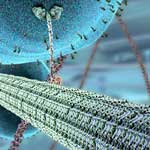 While the concept of a 'machine' can be extended to the nano-world, these nanomachines can not be built by just further miniaturizing machine blueprints from the macro-world. On the nanoscale, the nanomachine components would be atomic or molecular structures each designed to perform a specific task which, all taken together, would result in a complex function. The problem is that functional nanomachinery will need to take into account the quantum effects that dominate the behavior of matter at the nanoscale, affecting the optical, electrical and magnetic behavior of materials. An alternative approach to miniaturizing machines down to the nanoscale is to borrow from the highly successful design shop of Mother Nature. Until a few years ago, catalytic micro- and nanomotors have been more or less unknown outside biology. With the explosive growth in nanotechnology, however, catalyzed nanoscale motion has become a heavily researched phenomenon. Scientists find that there is much to be learned from nature's motor systems for the development of artificial nanoscale machinery. Joseph Wang, who runs the Laboratory for Nanobioelectronics at the Department of NanoEngineering at UC San Diego, has just published a review where he addresses the question: Can Man-Made Nanomachines Compete with Nature Biomotors?
While the concept of a 'machine' can be extended to the nano-world, these nanomachines can not be built by just further miniaturizing machine blueprints from the macro-world. On the nanoscale, the nanomachine components would be atomic or molecular structures each designed to perform a specific task which, all taken together, would result in a complex function. The problem is that functional nanomachinery will need to take into account the quantum effects that dominate the behavior of matter at the nanoscale, affecting the optical, electrical and magnetic behavior of materials. An alternative approach to miniaturizing machines down to the nanoscale is to borrow from the highly successful design shop of Mother Nature. Until a few years ago, catalytic micro- and nanomotors have been more or less unknown outside biology. With the explosive growth in nanotechnology, however, catalyzed nanoscale motion has become a heavily researched phenomenon. Scientists find that there is much to be learned from nature's motor systems for the development of artificial nanoscale machinery. Joseph Wang, who runs the Laboratory for Nanobioelectronics at the Department of NanoEngineering at UC San Diego, has just published a review where he addresses the question: Can Man-Made Nanomachines Compete with Nature Biomotors?
Feb 4th, 2009
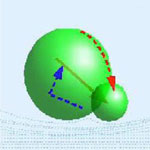 Advances in micro- and nanoscale engineering have led to various mobile devices that either can move on solids or swim in fluids. Researchers are applying various strategies to designing nanoscale propulsion systems by either using or copying biological systems such as the flagellar motors of bacteria or by employing various chemical reactions. Many of these approaches are fairly complex and not necessarily suited for large-scale deployment in practical applications. Scientists have theorized about simpler designs for mechanical swimmers that avoid the complexities of biological mechanisms and use very few degrees of freedom.
Researchers in Spain have now demonstrated the experimental realization of a simple device made by microscopic colloidal particles which can be externally controlled and propelled at low Reynolds number condition, i.e. when the viscosity of the fluid dominates over the inertia of the object. This is the same condition that governs the motion of bacteria such as E. Coli or other micro- or nanoscale objects that move in a fluid.
Advances in micro- and nanoscale engineering have led to various mobile devices that either can move on solids or swim in fluids. Researchers are applying various strategies to designing nanoscale propulsion systems by either using or copying biological systems such as the flagellar motors of bacteria or by employing various chemical reactions. Many of these approaches are fairly complex and not necessarily suited for large-scale deployment in practical applications. Scientists have theorized about simpler designs for mechanical swimmers that avoid the complexities of biological mechanisms and use very few degrees of freedom.
Researchers in Spain have now demonstrated the experimental realization of a simple device made by microscopic colloidal particles which can be externally controlled and propelled at low Reynolds number condition, i.e. when the viscosity of the fluid dominates over the inertia of the object. This is the same condition that governs the motion of bacteria such as E. Coli or other micro- or nanoscale objects that move in a fluid.
Dec 1st, 2008
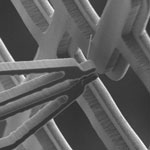 Nanotechnology researchers are actively working on the beginnings of various nanorobotic systems that one day could lead to automated, assembly-line type nanofabrication processes. Last year we reported on a nanogripper, a kind of a robotic 'hand' some ten thousand times smaller than a human hand. This 'pick-and-place' device used a silicon gripper which was controlled by a nanorobotic arm and was capable of picking up a carbon nanofiber and fix it onto the tip of an atomic force microscope cantilever. One of the problems that is vexing researchers is that the nanoscale miniaturization of these grippers comes at the cost of reduced strength - the smaller the gripper, the weaker it becomes. Therefore what is needed is a gripper design that is strong enough yet sufficient flexible and small to handle tough materials like carbon nanotubes.
Nanotechnology researchers are actively working on the beginnings of various nanorobotic systems that one day could lead to automated, assembly-line type nanofabrication processes. Last year we reported on a nanogripper, a kind of a robotic 'hand' some ten thousand times smaller than a human hand. This 'pick-and-place' device used a silicon gripper which was controlled by a nanorobotic arm and was capable of picking up a carbon nanofiber and fix it onto the tip of an atomic force microscope cantilever. One of the problems that is vexing researchers is that the nanoscale miniaturization of these grippers comes at the cost of reduced strength - the smaller the gripper, the weaker it becomes. Therefore what is needed is a gripper design that is strong enough yet sufficient flexible and small to handle tough materials like carbon nanotubes.
Nov 26th, 2008
 A very promising field of nanomotor research are DNA nanomachines. These are synthetic DNA assemblies that switch between defined molecular shapes upon stimulation by external triggers. They can be controlled by a variety of methods that include pH changes and the addition of other molecular components, such as small molecule effectors, proteins and DNA strands. Researchers have now designed and built a simple DNA machine that is capable of continuous rotation with controlled speed and direction - a function that might be very useful for example for molecular transport. This machine is driven by an externally controlled electric field. When this field is oscillated between four directions, it continuously reorients a rotor DNA that is asymmetrically attached to a DNA axle.
A very promising field of nanomotor research are DNA nanomachines. These are synthetic DNA assemblies that switch between defined molecular shapes upon stimulation by external triggers. They can be controlled by a variety of methods that include pH changes and the addition of other molecular components, such as small molecule effectors, proteins and DNA strands. Researchers have now designed and built a simple DNA machine that is capable of continuous rotation with controlled speed and direction - a function that might be very useful for example for molecular transport. This machine is driven by an externally controlled electric field. When this field is oscillated between four directions, it continuously reorients a rotor DNA that is asymmetrically attached to a DNA axle.
 Subscribe to our Nanotechnology Spotlight feed
Subscribe to our Nanotechnology Spotlight feed





